If you disengage from the previous styles of leadership, which were based on a strong, authoritarian superior, who did not involve his employees in decisions, expected unconditional obedience, sanctioned in case of a mistake and understood decisions as orders, then this has a great influence on the thinking of all those involved. With the agile, abilities are now appearing on the screen that have been described by chaos, complexity, social and systems sciences for decades. Systems thinking offers approaches that contribute to the new agility.
Let us look at the new ways of thinking that Barry Richmond described briefly at the turn of the millennium and that are reproduced here in slightly different ways.
- Dynamic thinking
The analytical thinking becomes clear through a focus on the individual parts, technical variety, valuing consideration, clear measuring points, strict organization and objective science. The new paradigms have worked out that through this view important aspects get lost.
Systems thinking, in contrast, is based on holistic thinking, interdisciplinary collaboration, relationships between the elements, the mapping of different perspectives, difficult to measure properties, processes, and epistemic science (more here).
Agility draws its advantages from considering the process-oriented behavior and the related milestones as well as the active coherence and dependencies. - System-as-Cause Thinking
In the past the starting point for activities were the influencing factors that affected a system (System-as-Effect). With the recognition that the system is the cause of its behavior, the attention was shifted to the creation of guidelines and open forms of collaboration.
Agility uses simple rules and promotes the self-organization of those involved to respond to Volatile, Uncertain, Complex and Ambiguous circumstances. - Forest Thinking
The categorizing, continuously drilling-down approach of the past, which, with more and more computer power, has led to not seeing the forest for the trees, is now being replaced by a holistic way of thinking that approaches the problem by looking at the whole, the forest. In this way you get through the coherence, the relationships and dependencies closer to a viable solution.
The agile thinking promotes this by making everyone responsible for the whole and to make decisions accordingly. - Operative thinking
The emphasis in analytical thinking is on the factors that lead to a behavior. This comprises education, training or the lived experiences. They move into the center of the treatment, which gets designed and predicted. In contrast, operational thinking focuses on the behavior – especially on the current, visible action. This allows looking at the issues that one intends to deal with. At the same time, solutions can be derived that lead to an immediate change in behavior.
You are not agile theoretically, but always practically by focusing on tasks that produce viable results. - Circular thinking
If one moves in a one-way street and a cause is followed by an effect that is a cause that is followed by an effect, … then this corresponds to analytical thinking. This is stimulated by the fact that we can only process 7plusminus2 facts at the same time. Actually, we always operate in a dynamic environment, which means that one cause leads to many effects, which in turn produce many effects and, under certain circumstances, lead to a feedback to the first cause. Because of our modest power of imagination, we avoid circular thinking because it overloads us, and we feel forced to escape into simplifications.
Agility uses short control loops, e.g. sprints, which take a maximum of four weeks, to produce all kinds of results. - Qualitative thinking
Through the legacy of analytical thinking, the focus on metrics and measures, most of us, will always look for the next key indicators to support our decision makings. The result of an addition (e.g. 1+1=2) is not a decision, but only a logical consequence of using mathematics. Decisions require qualities, if you are looking for patterns in behavior in order to decide whether you do something like this or like that.
Agility therefore also looks for the soft factors that determine progress and it prefers intuitive opinions to hard facts. - New scientific thinking
The biggest road block of analytical thinking is that the obvious goal is always to confirm one’s own hypothesis. And this, although Karl Popper introduced falsification into scientific work very early on – the idea that one must always strive to refute one’s own thesis. The next point is that one must always present one’s argument in such a way that everyone can show its falsity. Therefore, appropriate test cases must be prepared.
Agility promotes this approach through cross-functional teams, which are not determined by distributed tasks, e.g. developers and testers, but by a joint responsibility for all aspects of the outcome.
Bottom line: It is the attitude that determines the agile future. This includes known skills that have been used for years and have proven themselves. These different thinking styles (see above) are contrary to our spiritual strengths and the practiced behavior patterns, but they follow laws that have proven themselves in nature. Once the acquired node of analytical thinking is unraveled in our mind through consciously striving toward systems thinking, the above thinking styles can be applied easily. The good news is: the agile benefits from systems thinking.

